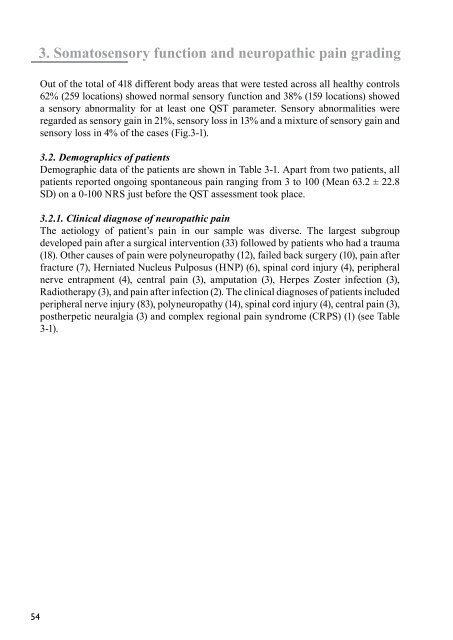Quantitative Sensory Testing (QST) - Does assessing ... - TI Pharma
Quantitative Sensory Testing (QST) - Does assessing ... - TI Pharma
Quantitative Sensory Testing (QST) - Does assessing ... - TI Pharma
Create successful ePaper yourself
Turn your PDF publications into a flip-book with our unique Google optimized e-Paper software.
3. Somatosensory function and neuropathic pain grading<br />
Out of the total of 418 different body areas that were tested across all healthy controls<br />
62% (259 locations) showed normal sensory function and 38% (159 locations) showed<br />
a sensory abnormality for at least one <strong>QST</strong> parameter. <strong>Sensory</strong> abnormalities were<br />
regarded as sensory gain in 21%, sensory loss in 13% and a mixture of sensory gain and<br />
sensory loss in 4% of the cases (Fig.3-1).<br />
3.2. Demographics of patients<br />
Demographic data of the patients are shown in Table 3-1. Apart from two patients, all<br />
patients reported ongoing spontaneous pain ranging from 3 to 100 (Mean 63.2 ± 22.8<br />
SD) on a 0-100 NRS just before the <strong>QST</strong> assessment took place.<br />
3.2.1. Clinical diagnose of neuropathic pain<br />
The aetiology of patient’s pain in our sample was diverse. The largest subgroup<br />
developed pain after a surgical intervention (33) followed by patients who had a trauma<br />
(18). Other causes of pain were polyneuropathy (12), failed back surgery (10), pain after<br />
fracture (7), Herniated Nucleus Pulposus (HNP) (6), spinal cord injury (4), peripheral<br />
nerve entrapment (4), central pain (3), amputation (3), Herpes Zoster infection (3),<br />
Radiotherapy (3), and pain after infection (2). The clinical diagnoses of patients included<br />
peripheral nerve injury (83), polyneuropathy (14), spinal cord injury (4), central pain (3),<br />
postherpetic neuralgia (3) and complex regional pain syndrome (CRPS) (1) (see Table<br />
3-1).













